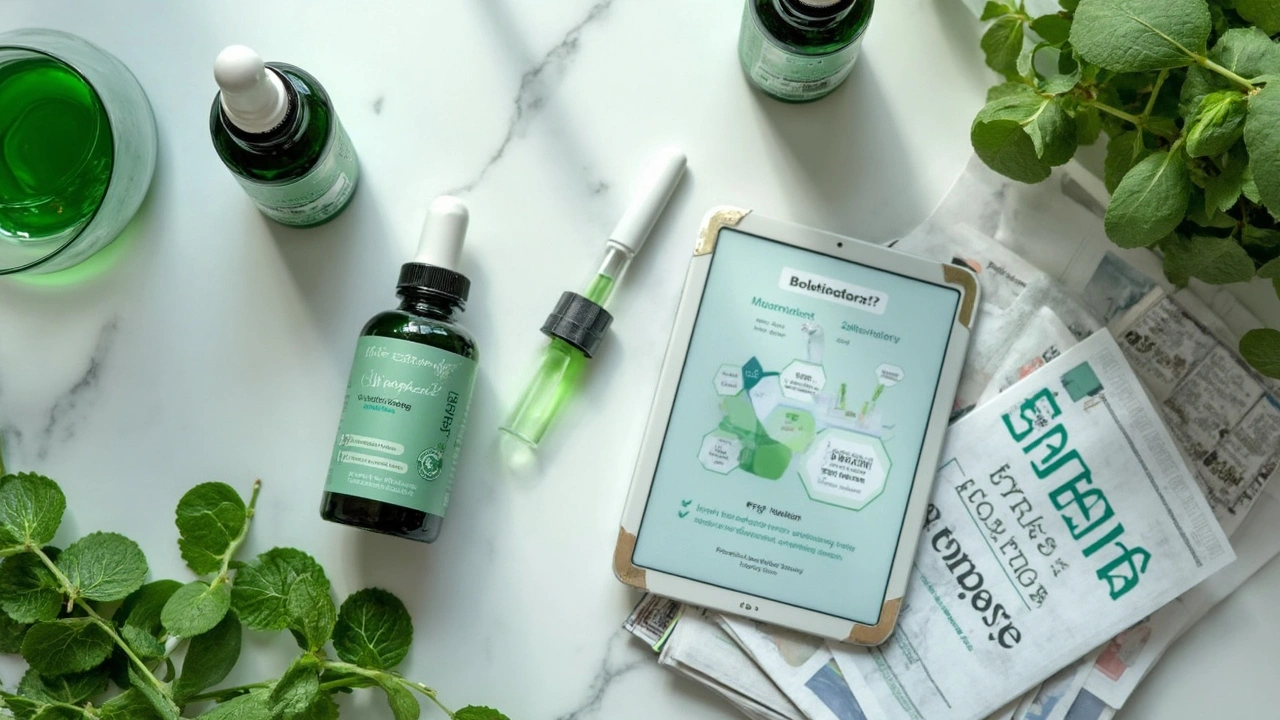That weird green shot suddenly showing up in juices, skin products, and most influencer shopping lists? It's chlorophyll—the stuff that gives plants their color and helps them turn sunlight into food. Yeah, we learned this in high school biology, but nobody mentioned it could turn up in your smoothie or play sidekick to your morning coffee. Here in Sydney, people are picking up bottles of chlorophyll supplements like they’re the next avocado toast. But can a single molecule really be nature’s secret weapon for better health, or is it just a TikTok fad?
What Makes Chlorophyll Unique Among Supplements?
Chlorophyll stands out because it's literally the green juice of life for plants, capturing light energy and turning it into food. That’s photosynthesis—turning carbon dioxide, water, and a dash of sunlight into energy, with oxygen as the bonus round. The surprising part? The structure of chlorophyll looks a lot like haemoglobin, the hero molecule inside our red blood cells that hauls oxygen around. Both structures feature a ‘ring’ at their core, with magnesium at the heart of chlorophyll and iron in haemoglobin.
Why does this matter? There’s a long-running thought that because they resemble each other, chlorophyll might help blood health. This theory goes back to supplements in the 1940s when wheatgrass juice was pushed as an energy booster (while jazz was still hot on the radio). While modern research is a bit more careful, there’s evidence to suggest that chlorophyll has anti-inflammatory, antioxidant, and potential blood-building abilities. It’s even found a place in oral hygiene products because it can neutralize odd odors, apparently making morning breath less weaponized.
Pretty wild, right? But don’t expect a miracle. The human body doesn’t actually use plant chlorophyll directly as it does haemoglobin; enzymes in your intestines break it down, and what you really absorb are molecules like chlorophyllin—the water-soluble cousin designed for supplements. Still, these green molecules, whether natural or synthetic, seem to pack benefits.
Science-Backed Benefits: What Evidence Says About Chlorophyll Supplements
If there’s one thing Aussies love, it’s a straight answer. So, what do studies show? A 2016 clinical trial in the journal Appetite found that people who took chlorophyll-rich compounds alongside meals reduced their food intake at a later buffet, possibly because chlorophyll plays with hormones that control hunger signals—GIP and GLP-1, for those who like the details. Basically, participants felt full sooner, which could be handy if your jeans are starting to feel snug.
Skin health is another big claim. In 2018, a study in the Journal of Clinical and Aesthetic Dermatology tested topical and supplemental chlorophyll in people with mild to moderate acne. Results leaned positive: redness went down, healing sped up, and overall skin texture improved. It’s not magic, but if you’re tired of chemical spot creams, that’s encouraging. Plus, chlorophyll’s antioxidant punch may help skin bounce back from sun and pollution damage, which is handy under the Aussie sun.
On the inside, animal research and a pilot human study have hinted that chlorophyll or chlorophyllin could help the liver get rid of toxins more efficiently, by binding to the likes of aflatoxin (a nasty mold toxin found in some foods). A small study with residents in China, who were at high risk for liver cancer due to food contamination, tracked fewer dangerous metabolites in participants who took chlorophyllin. It’s not a greenlight for chomping on dodgy leftovers, but does point to impressive detox potential.
Ever heard that green juices boost energy? That carries over to supplements, too. The theory is that by improving red blood cell quality, some people feel more energetic. While there’s not mountains of hard data, a 2014 study in the British Journal of Nutrition observed better exercise tolerance in rats given chlorophyll supplements. Not exactly Olympic evidence, but people often report feeling less sluggish and more alert—especially if they swap out sugary drinks.
| Benefit | Study/Source |
|---|---|
| Appetite Control | Appetite (2016) |
| Skin Improvement | Journal of Clinical and Aesthetic Dermatology (2018) |
| Liver Detox | Cancer Epidemiology, Biomarkers & Prevention (2001) |
| Odor Reduction | Old (1940s) clinical observations; supported by current mouthwash products |
Now don’t expect chlorophyll to replace medical treatment or cure diseases, but the research is enough to justify giving this green powder or liquid a spot at the breakfast bar.

How Chlorophyll Supplements Work in the Body
Take a shot of liquid chlorophyll—or mix it in your water—and your body jumps into action to process it. Chlorophyll as it appears in plants (chlorophyll a and b) is fat-soluble and breaks down fast in the stomach. In supplements, you’ll mostly get chlorophyllin, which is water-soluble and easier to absorb. The main difference? Chlorophyllin swaps out that central magnesium atom for copper, so it’s more stable in pill or drop form. This processed version is what does most of the heavy lifting in human bodies, whether you chug it down or dab it on your skin.
When digested, chlorophyllin acts as an antioxidant. It grabs damaging molecules (free radicals) before they mess with your tissues. This process is similar to how you benefit from green veggies, but concentrated. Because of its copper core, chlorophyllin also has mild anti-bacterial properties, which helps explain its use in wound gels and mouthwashes. Another unique feature? It can bind to mutagens—chemicals that mess with DNA—and help shuttle them out. If you’ve had a dodgy meal or a bit too much BBQ, chlorophyll’s binding potential is nice to have on your side.
The verdict: it’s not just about what gets absorbed after you take a supplement. Sometimes chlorophyll works as a sort of internal broom, sweeping up bad guys in your gut before they have a chance to sneak into your bloodstream. That’s why some people report less bloating, steadier energy, and even nicer-smelling sweat when taking chlorophyll regularly.
Here’s a wild fact for runners and gym buffs: some endurance athletes in Australia are experimenting with chlorophyll, hoping for a natural edge on oxygen use. While not banned by sporting authorities, there’s zero proof it helps elite performance. Still, anecdotal reports of better recovery are common enough for brands to lean into it in their advertising.
How to Use Chlorophyll Supplements Safely and Effectively
This is the big question: what’s the best way to take chlorophyll supplements to see benefits, without risking side effects? For starters, always check the label. Most people in Sydney grab their chlorophyll as a liquid—usually 5-15 ml added to water, once or twice a day. Others go for capsules or tablets, which are easier to travel with but might absorb slower.
- Drink it diluted: Pure chlorophyll can be a little rough on the stomach. Always add your drops to a full glass of water or juice.
- Start slow: If you’ve never tried it before, begin with a low dose and watch for any cramps, diarrhea, or weird taste changes. Your gut needs time to adjust.
- Timing: Some swear by taking it in the morning for a natural energy buzz, while others like it after lunch to beat the 3PM crash. Try both and see what sticks.
- Pair with healthy fats: If you’re using a natural (non-chlorophyllin) product, a splash of olive oil or avo can help your gut absorb it better.
- Keep it cool: Chlorophyll can break down in hot drinks or direct sunlight, so keep your bottle in the fridge and don’t add it to coffee or tea.
Safety-wise, most people tolerate chlorophyll with no issues. But go easy if you’re pregnant, have kidney disease, or take meds affected by copper levels. If your urine or poop turns greenish—don’t freak out! That’s pretty common, and harmless.
Chlorophyll supplements are not for everyone. There are rare cases of allergic reactions, so if you break out in a rash or feel your throat tightening, stop right away and see a doctor. For most Aussies, though, chlorophyll is as safe as a handful of spinach, as long as you don’t chug half a bottle in a sitting.

Busting Myths and Common Questions About Chlorophyll
There are plenty of wild claims about what chlorophyll can do, so let’s cut through the noise. The most eyebrow-raising myth? That chlorophyll can "oxygenate" your blood the same way plants do for themselves. Nice idea, but our bodies don’t work that way—we get our oxygen via breathing, not from what we drink.
- Chlorophyll won’t cure chronic diseases. It can support wellness, but skip any product promising to reverse cancer, diabetes, or other serious medical conditions.
- Chlorophyll helps with bad breath and BO, but that doesn’t mean it’ll replace brushing your teeth or using deodorant. It’s more like an assist.
- If you hate veggies, you can use chlorophyll to get some green benefits, but you’re still missing fiber, vitamins, and everything else real food has.
- Yes, you can get chlorophyll from wheatgrass shots, spirulina, or lots of leafy greens—but you need to eat or juice a lot to get anywhere near supplement levels.
- Chlorophyll water doesn’t taste like grass clippings unless you overdo it. Mixed well, most describe the taste as "fresh" or barely noticeable.
If you’re wondering whether it’s better to go for natural or synthetic forms, chlorophyllin (the supplement version) is just more practical for most folks. It’s easier to find, more stable on the shelf, and absorbs fine. Natural purists might stick to eating their greens, but supplements offer a simpler path if you’re busy or don’t like salads. Still, even the best supplement can’t outdo wholesome meals packed with veggies—a fact every nutritionist agrees on.
For anyone living in a city with lots of pollution, sun, and food temptations (hello, late-night barbecue chicken runs), adding a touch of *chlorophyll supplements* into your daily routine might help tip the balance toward feeling better. Give it a try, see how you feel, but keep your expectations realistic—nature’s secret weapon works best as part of a healthy, balanced life and a bit of skepticism about miracle claims.

Phillip Gerringer
May 19, 2025 AT 05:27Let’s be real - chlorophyllin isn’t a supplement, it’s a molecular placebo dressed in green dye. The structural similarity to hemoglobin is a textbook coincidence, not a mechanism. Your body doesn’t ‘use’ plant chlorophyll to build blood - that’s a 1940s pseudoscientific myth resurrected by influencer marketing. The so-called ‘detox’ claims? That’s just binding to dietary mutagens, which you’d get more effectively from cruciferous vegetables. And no, drinking chlorophyll won’t ‘oxygenate’ your blood. That’s not how physiology works. You breathe oxygen. End of story. This isn’t wellness - it’s biochemical theater.
Also, if you’re taking this to ‘beat the 3pm crash,’ you’re probably just dehydrated and eating too much sugar. Fix your diet before buying $30 bottles of algae water.
And yes, I’ve read the 2016 Appetite study. The effect size was tiny, the sample size was small, and they didn’t control for placebo expectation. This isn’t evidence - it’s noise.
Stop treating chlorophyll like a magic bullet. It’s not. It’s a pigment. And you’re paying for it like it’s liquid gold.
jeff melvin
May 20, 2025 AT 10:22Matt Webster
May 21, 2025 AT 07:04I’ve been taking chlorophyll for about six months now - not because I believe in miracles, but because I noticed subtle shifts. My digestion felt lighter, my skin stopped getting that dull, tired look after long workweeks, and honestly, my morning breath is less… intense. I don’t think it’s curing anything. But I also don’t think it’s doing nothing.
I started with a teaspoon in water, kept it cold, and didn’t expect much. Now I notice I reach for it when I’ve eaten too much processed stuff - like a gentle reset button. It’s not a replacement for veggies. But if you’re already eating greens, adding a little extra might be like adding a quiet harmony to a song you already love.
I’m not here to sell it. I just know what I’ve felt. And sometimes, that’s enough.
Also - green poop? Yeah, mine turned neon. Didn’t panic. Just laughed. It’s not poison. It’s just… green.
Stephen Wark
May 22, 2025 AT 02:59Okay but why is this everywhere now? I saw a guy at the gym chugging chlorophyll water like it was a protein shake and then posted a TikTok with the caption ‘my liver is crying tears of gratitude.’
Are we seriously doing this? Next thing you know, people will be rubbing spinach on their foreheads for ‘third eye activation.’
It’s not that the science is wrong - it’s that it’s being weaponized by people who think ‘natural’ means ‘magical.’ You’re not detoxing your liver with a $25 bottle of liquid grass. You’re just drinking dyed water with a side of confirmation bias.
And the ‘energy boost’? Bro, you’re replacing soda with water and suddenly you’re ‘vibrating higher.’
Stop selling snake oil and start selling common sense.
Also - why does every chlorophyll bottle look like it was designed by a 12-year-old who just discovered neon paint?
Daniel McKnight
May 23, 2025 AT 05:25Chlorophyll’s not the hero - but it’s not the villain either. It’s a quiet player. Like turmeric. Or ginger. Or garlic. You don’t need to hype it up to see value.
I mix mine with lemon and sparkling water - tastes like a garden after rain, honestly. No green teeth, no stomach drama. Just… calm. I don’t track my biomarkers. I don’t post about it. But I notice I sleep better when I’ve had it for a few days straight.
It’s not a cure. It’s not a trend. It’s just… a little green help in a world full of chemical noise.
And hey - if it makes you drink more water? That’s already a win.
Also - the green poop thing? That’s the universe giving you a high five. Embrace it.
Keep it simple. Keep it real. And for god’s sake, don’t chug it straight from the bottle. That’s just asking for a one-way ticket to the porcelain throne.